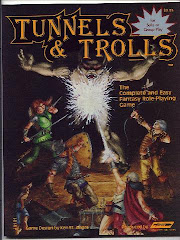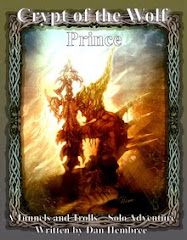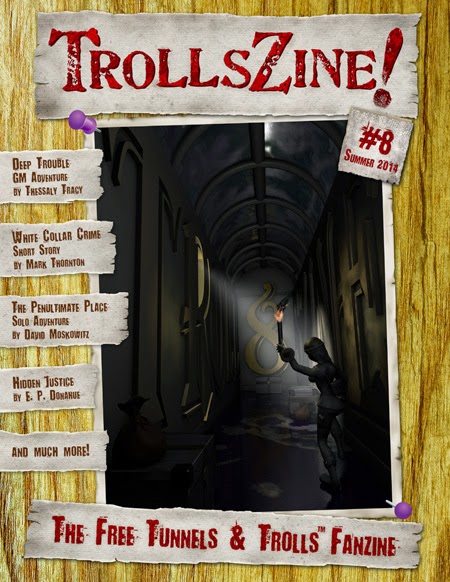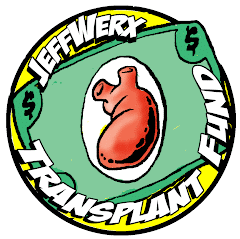 Continuing my discussion of human kindred modifiers, here are three ways of making the human kindred a more appealing option. With each I've provided an example of the effect of the modifier.
Continuing my discussion of human kindred modifiers, here are three ways of making the human kindred a more appealing option. With each I've provided an example of the effect of the modifier.1. Start with more gold
My own idea was to provide human characters the chance to start with more gold. This is equal to 3D6 x 10 gold pieces with a 2x modifier (my new personal favorite level of upgrade). My logic behind this house rule was that humans tend to rely on equipment to keep them safe from harm; giving them more gold at the start allows them to acquire more gear. Here is a potential outcome of this house rule:
Standard: Roll 3D6 x 10 = 70 gp
Modified: Roll 3D6 x 10 = 70 x 2 = 140 gp
That's 70 more gold for the human over the other kindred. That's enough for a wide variety of extra weapons, an upgrade in armor, a nice set of miscellaneous equipment, or a few first aid kits. Here is how you can equip a human and a dwarf with these amounts:
Human (140 gp): Spear (3+1), 2 Banks (2+3), Leather jerkin (1 hit), Bracers (2 hits), Greaves (2 hits), Coif (2 hits), Buckler (3 hits), Backpack, Flint and steel, Lantern, 2 flasks of oil, 50' hemp rope, waterskin, large sack, first aid kit, 2 gp, 6 sp
Dwarf (70 gp): Taper axe (3), Adze (3), Bracers (2 hits), Greaves (2 hits), Buckler (3 hits), Backpack, Flint and steel, 4 torches, waterskin, large sack, 3 gp
That's a pretty big difference as you might expect. The human gets more armor and weapons and more complete set of general gear including a first aid kit. Overall this may help him survive despite his relatively lower strength and constitution. But of course not every human has to start with a lot of gold. You could always roll low; even with a 2x modifier the nonhuman may end up with more gold and consequently better gear.
2. Roll 4D6 for all attributes and drop the lowest:
A common idea to give humans a boost is to roll 4d6 for generating all attributes and dropping the lowest die. This provides a potentially huge advantage for starting human characters. The logic behind this rule is that human delvers are not the normal human stock, but are exceptional. Rolling 4D6 allows one to create these exceptional characters. But what about the other kin? Do they not produce exceptional individuals? Do only common dwarves and elves go delving?
Below is a sample outcome of this rule. For the sake of comparison I rolled 3D6 for the standard method, then rolled another 1D6 for the modified and dropped the lowest die.
Standard (3D6):
ST 8
CON 10
DEX 8
SPD 15
INT 11
WIZ 5
LK 10
CHR 8
Adds +1
Modified (4D6 drop lowest):
ST 10
CON 15
DEX 10
SPD 16
INT 26
WIZ 10
LK 15
CHR 13
Adds +7
As you can see the 4D6 method resulted in a very different character, potentially a 2nd level Rogue, Wizard, or Specialist Mage in fact according to the 7th edition rules.
We can compare this to a dwarf or elf using the attribute modifiers from 7th edition and applying them to the 3D6 rolls above:
Dwarf (3D6):
ST 16
CON 20
DEX 8
SPD 15
INT 11
WIZ 5
LK 7
CHR 8
Adds +4
Elf (3D6):
ST 8
CON 7
DEX 8
SPD 15
INT 17
WIZ 10
LK 15
CHR 16
Adds +4
In all accounts I'd say the human has the better attributes. The elf might make a decent wizard, but he lacks the Dexterity to cast even first level spells. The dwarf has more problems, he's clumsy, unlucky, and kind of ugly. But this is not all together bad because these kinds of below average attributes can be used to define a character as much as the above average attributes. The problem with the 4D6 method is that you produce characters that don't have these fun quirks.
3. Replace one die roll with a '6'
This house rule actually comes from a OD&D variant play-by-post game that I am involved in at the OD&D Discussion Forum, Deep in the Hinterlands (Yes, I do play 'that game'). With this rule, a player may choose one die roll from any attribute and replace it with a '6.' This is not the huge advantage of the 4D6 method because it only affects one attribute. I like this option, however, because it can produce one exceptional attribute. This can be any attribute and it will vary from human to human. This really reflects the variability present within the human gene pool.
Here are some examples (attributes with an asterisk have been modified):
Standard (3D6):
ST 9 (1,3,5)
CON 10 (4,2,4)
DEX 10 (5,2,3)
SPD 7 (1,5,1)
INT 12 (5,3,4)
WIZ 10 (4,1,5)
LK 14 (5,3,6)
CHR 8 (1,4,3)
Adds +0
Modified 1:
ST 14*
CON 10
DEX 10
SPD 7
INT 12
WIZ 10
LK 14
CHR 8
Adds +2
Modified 1:
ST 9
CON 10
DEX 10
SPD 7
INT 12
WIZ 10
LK 17*
CHR 8
Adds +3
Modified 3:
ST 9
CON 10
DEX 10
SPD 12*
INT 12
WIZ 10
LK 14
CHR 8
Adds +2
Three different choices and three different characters depending on what the player wants. The third choice was the safest, eliminating the one real weakness of the character: Speed. This option can also help a player create a character with attributes that favor a particular type, for example boosting ST or DEX for a warrior or INT or WIZ for a wizard.
As I've stated before, I have other reasons to play human characters in T&T so mechanical advantages are not really necessary for me. These house rules do help to improve their chances of survival in a dangerous world, however, especially in the realm of solo adventures.

















